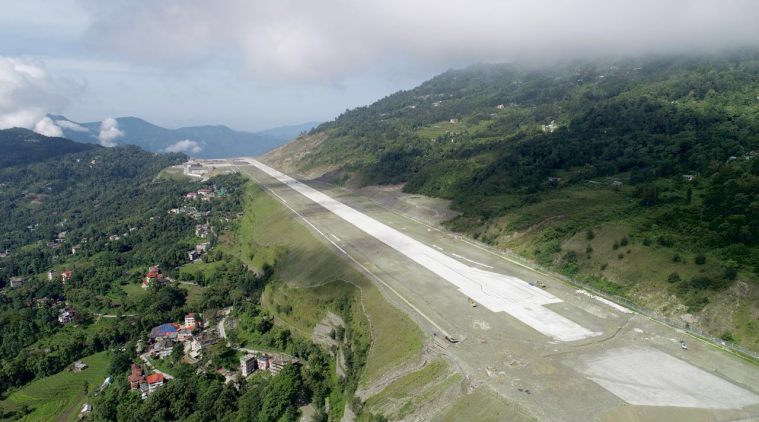[A picture of the runway of Sikkim’s new airport at Pakyong clicked in July. Photo Courtesy: Airports Authority of India.]
In October last year, I was happy to hear the news on the telly about a spanking new airport at Pakyong, near Gangtok, in Sikkim. My wife and I had made the somewhat arduous journey to Gangtok back in 1996, taking an overnight train to New Jalpaiguri from Kolkata. And then enduring more than a five hour uphill bus journey from Siliguri to Gangtok, past the meandering emerald green waters of the Teesta.
I’ve always wanted our family to visit Sikkim—and the prospect of a direct flight from Kolkata was alluring. The airport is, in many ways, an engineering marvel. Perched between the Himalayan ranges at 4,500 feet above sea level, the land for the airport was carved from a mountainside using modern engineering methods. Built at an estimated cost of Rs 605 crore, the airport is expected to boost tourism, trade and commerce, and connect the North-Eastern region to the rest of the country and also to neighbouring countries such as Bhutan and Nepal.
But what’s more important is that it is also an important test case for Udan, India’s game-changer in the civil aviation space. Launched with much fanfare in October 2016, Udan’s mandate is to built both greenfield airports and restart defunct airports in far-flung locations, and open up new air routes that address the issue of regional connectivity, in order to make air travel accessible for all Indians. Hence, the acronym Udan. Or, Ude Desh Ka Aam Nagrik.
A new breed of regional airlines and existing mainline airlines would bid for these new routes and the winner would enjoy an exclusive access for three years. And by capping the price of half the inventory of seats, air fares would remain affordable. And this would be achieved by creating a viability gap fund for the airline operators, through a combination of a cess imposed on the tickets in the main routes. Plus, there would be certain tax concessions in ATF fuel from both the Centre and the states—and waivers of landing charges from airport operators.
On the face of it, it looks like a neat plan. But there are some flies in the ointment. Consider a few key ones:
Building a greenfield airport isn't enough, unless flights are able to take off and land. Inclement weather conditions make it difficult for flights to land in Pakyong on most days. And the airport does not have the somewhat expensive instrument landing systems (ILS) in place. Cancellations are therefore common. And the repeated cancellations make it difficult to build traffic on the route on a sustained basis. Most people end up flying to the nearest Bagdogra airport, which has an ILS in place, and then driving up to Gangtok. How that will make the Pakyong airport sustainable is anybody’s guess.
While the infra challenge might be easier to fix, the bigger challenge is putting in place an ideal network design. The key is to discover routes where there is sustained traffic, not just in a few months of the year, but all round the year. That’s why it is far easier to generate steady, predictable traffic, by following a hub and spoke design by connecting the large metro airports to the new Udan routes, as opposed to a point-to-point service say, from Jalgaon to Indore. India’s metro airports, Mumbai, Delhi and to a large extent, Bangalore, are choked. They have run out of capacity in terms of landing and parking slots. To make matters worse, passenger traffic continues to gallop at nearly 18-20 per cent every year. And the existing airlines have responded to the market demand by ordering aircraft that could almost double the existing aircraft capacity in another three years. This will stretch India’s airport capacity in the metros even further.
And the biggest casualty will be the Udan routes, for which the airport operators are expected to waive off landing and parking charges. They reluctantly agreed in the first two years, but now, they’re asking for a share of the viability gap fund. Take for instance, the Durgapur-Delhi Udan route that Air India resumed last year, after a gap of two years. The traffic has been strong from the steel and mining hub in the East, given that earlier passengers had to travel all the way to Kolkata for a flight to Delhi or rely on the more time-consuming train service. Most businessmen prefer to fly to their destination, wrap up their work and preferably return the same evening, thereby saving money on hotel accommodation. Initially, the Delhi airport was able to offer a flight to Durgapur at 4:30 AM (which meant passengers would have to check-in around 3:30 AM), but later, after much persuasion, settled for a 5:50 AM departure. Finding convenient time slots will be a challenge.
Because the number of runways aren’t increasing (except to some extent, Delhi, which will have a fourth runway in the next two years.)
India is scrambling to create additional airports across the major metro cities. Things could improve a wee bit once new airports come up near Delhi (first at Hindon, near Ghaziabad and later at Jewar in Greater Noida) or Mumbai (Navi Mumbai), and the existing international airport at Kempegowda in Bangalore, India’s third busiest airport, looks to dramatically up its capacity to handle 45 million passengers—from the existing 27 million—with a $2 billion expansion plan.
Now, contrast that with China and Turkey, both of whom are consolidating their hubs in Beijing and Istanbul with mega, new world-class airports, to tap into the growing demand for air travel in Asia. China’s Daxing airport, which is slated to open in September this year, will be able to handle 72 million passengers with four runways. On the other hand, the estimated $12 billion that’s going into the new Istanbul airport is likely eventually cater to 200 million passengers, almost double that of Hartsfield-Jackson Atlanta International Airport in the US, currently the biggest airport in the world.
There’s one central reason why India is unable to build such integrated mega airports: unavailability of land. And add to it, the lack of long-term planning, especially since capacity invariably exceeds that of traffic within a few years of a new airport opening.
Despite these handicaps, the new airport at Hindon could help passengers from Delhi and Noida save a long commute to Gurgaon and somewhat ease the burden for airlines to find convenient time slots, particularly for the Udan routes. No wonder Air Odisha and the relaunched Air Deccan were stripped off their licenses on Udan routes in November when they were unable to start operations for more than a year. There are already considerable debate whether there is a business case for a regional airline. According to Centre for Aviation (CAPA), the consultant in the aviation space, it is far from clear. Other than Tru Jet, which claims an occupancy of 85 per cent, none of the other regional airlines have displayed the confidence of staying invested.
So far, IndiGo, Alliance Air, Jet and SpiceJet have found it easier to make headway on the new Udan routes than the new regional carriers. After all, it is far easier to extend their existing network and leverage their current slots at the metro airports. On the other hand, the regional airlines don’t have the advantage of any pre-existing slots in Delhi and Mumbai. Besides, the cost per seat is often higher in a smaller aircraft. And unless there is a steady demand, like it is with the newly opened airport at Kannur, which is witnessing steady growth in passenger traffic, especially on the Gulf routes. Within one month of opening, there are reports of more than 42,500 passengers using the airport for both international and domestic travel. Once the Hindon airport is ready, there are reports that Air India is likely to use it as a base to start a new service between Hindon and Kannur later this month.
So far, the experience with UDAN has been a mixed bag. The intent of the policy—to expand the market—is clearly in the right direction. But unless urgent steps are taken to upgrade airport infrastructure, the idea of regional connectivity might remain a pipe dream.
(A shorter version of this column was first published in Business Standard)


